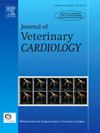兽医超声心动图医师对狗左心房二维尺寸评估的图像选择、时间和卡尺放置的偏好:BENEFIT项目
IF 1.3
2区 农林科学
Q2 VETERINARY SCIENCES
引用次数: 0
摘要
本研究旨在探讨兽医超声心动图医师使用线性二维超声心动图评估犬左房(LA)大小的偏好,重点关注左房放大的图像选择、时间、卡尺放置和阈值。第二个目的是探索经验和训练对超声心动图师对狗的LA大小的线性二维测量的影响。动物、材料和方法进行了一项全球在线研究,要求兽医超声心动图医师使用静态超声心动图图像测量LA大小。结果共有533名超声心动图医师(非专科医师63%,专科医师37%,其中43%获得心脏病学委员会认证)完成研究。大多数超声心动图医师(86%,n = 459/533)使用右胸骨旁短轴(RPSAX)视图测量LA和主动脉(Ao)。其中,57% (n = 261/459)倾向于采用相同的成像角度进行测量,76% (n = 351/459)倾向于在收缩期末/舒张期早期进行定时测量。卡尺放置在肺静脉入口附近对其LA尺寸测量影响最大。39% (n = 207/533)使用右胸骨旁长轴(RPLAX)视图。在所有常用的方法中,LA放大的上限各不相同。训练和经验水平影响从RPLAX四室视图中获得的LA维度测量的观察者间差异,但从RPSAX视图中没有。研究局限性静态图像可能不能反映实时临床环境或允许精确识别解剖结构。结论RPSAX视图最适合犬的LA大小评估,但在图像选择、时间、卡尺放置和LA放大阈值方面存在差异。训练和经验水平影响从RPLAX四室视图获得的LA维度测量的观察者间差异。本文章由计算机程序翻译,如有差异,请以英文原文为准。
Veterinary echocardiographers’ preferences for image selection, timing, and caliper placement for left atrial two-dimensional size assessment in dogs: the BENEFIT project
Introduction/Objectives
This study aimed to investigate veterinary echocardiographers’ preferences for assessing left atrial (LA) size in dogs using linear two-dimensional echocardiography, focusing on image selection, timing, caliper placement, and thresholds used for LA enlargement. A secondary aim was to explore the impact of experience and training on echocardiographers' linear two-dimensional measurements of LA size in dogs.
Animals, Materials and Methods
A global online study was conducted, asking veterinary echocardiographers to measure LA size using static echocardiographic images.
Results
A total of 533 echocardiographers (63% non-specialists and 37% specialists, of which 43% were cardiology board certified) completed the study. Most echocardiographers (86%, n = 459/533) used a right parasternal short-axis (RPSAX) view for LA and aortic (Ao) measurements. Of these, 57% (n = 261/459) favored the same image angulation for performing measurements and 76% (n = 351/459) timed measurements at end-systole/early-diastole. Caliper placement near pulmonary venous inlets impacted their LA dimension measurements the most. Thirty-nine percent (n = 207/533) used right parasternal long-axis (RPLAX) views. The upper limit for LA enlargement varied across all commonly used methods. Training and experience level influenced interobserver variation for LA dimension measurements obtained from a RPLAX four-chamber view, but not from a RPSAX view.
Study Limitations
Static images may not reflect real-time clinical settings or allow precise identification of anatomical structures.
Conclusions
The RPSAX view was most favored for LA size assessment in dogs, but variations existed in image selection, timing, caliper placement, and threshold used for LA enlargement. Training and experience level influenced interobserver variation in LA dimension measurements obtained from a RPLAX four-chamber view.
求助全文
通过发布文献求助,成功后即可免费获取论文全文。
去求助
来源期刊

Journal of Veterinary Cardiology
VETERINARY SCIENCES-
CiteScore
2.50
自引率
25.00%
发文量
66
审稿时长
154 days
期刊介绍:
The mission of the Journal of Veterinary Cardiology is to publish peer-reviewed reports of the highest quality that promote greater understanding of cardiovascular disease, and enhance the health and well being of animals and humans. The Journal of Veterinary Cardiology publishes original contributions involving research and clinical practice that include prospective and retrospective studies, clinical trials, epidemiology, observational studies, and advances in applied and basic research.
The Journal invites submission of original manuscripts. Specific content areas of interest include heart failure, arrhythmias, congenital heart disease, cardiovascular medicine, surgery, hypertension, health outcomes research, diagnostic imaging, interventional techniques, genetics, molecular cardiology, and cardiovascular pathology, pharmacology, and toxicology.
 求助内容:
求助内容: 应助结果提醒方式:
应助结果提醒方式:


